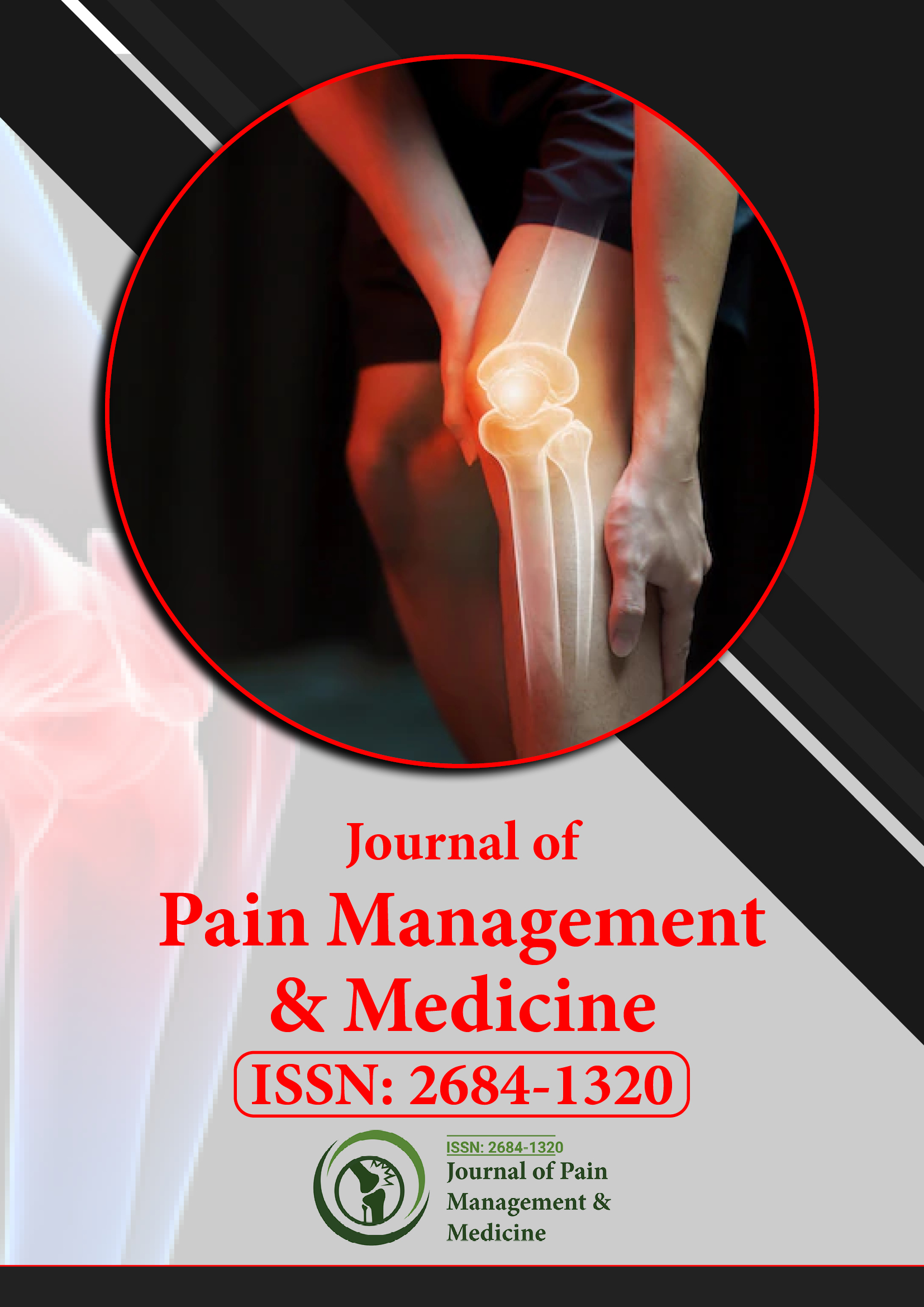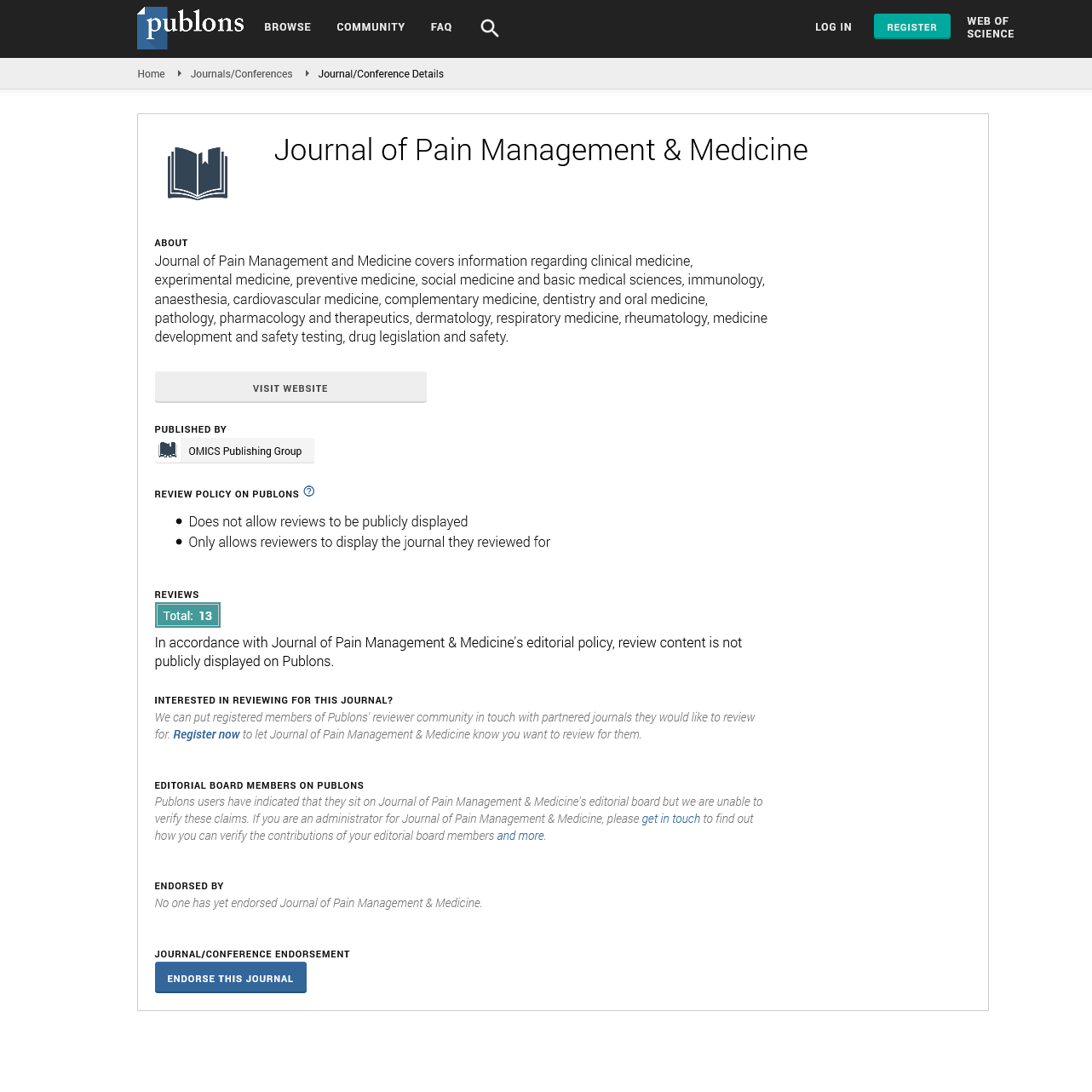Indexed In
- RefSeek
- Hamdard University
- EBSCO A-Z
- Publons
- Euro Pub
- Google Scholar
- Quality Open Access Market
Useful Links
Share This Page
Journal Flyer

Open Access Journals
- Agri and Aquaculture
- Biochemistry
- Bioinformatics & Systems Biology
- Business & Management
- Chemistry
- Clinical Sciences
- Engineering
- Food & Nutrition
- General Science
- Genetics & Molecular Biology
- Immunology & Microbiology
- Medical Sciences
- Neuroscience & Psychology
- Nursing & Health Care
- Pharmaceutical Sciences
Commentary - (2025) Volume 11, Issue 2
Uneven Playing Field: Socioeconomic Disparities in Access to and Outcomes of Multimodal Pain Management
Chen L Zao*Received: 01-Mar-2025, Manuscript No. JPMME-25-28849; Editor assigned: 03-Mar-2025, Pre QC No. JPMME-25-28849 (PQ); Reviewed: 17-Mar-2025, QC No. JPMME-25-28849; Revised: 24-Mar-2025, Manuscript No. JPMME-25-28849 (R); Published: 31-Mar-2025, DOI: 10.35248/2684-1320.25.11.319
Abstract
Description
Chronic pain is a pervasive health issue that transcends socioeconomic boundaries. However, the ability to access comprehensive and effective pain management, particularly multimodal approaches, is far from equitable. Socioeconomic factors – encompassing income, education, occupation, and social status – exert a profound influence not only on who develops chronic pain but also on their access to and the ultimate outcomes of multimodal pain management. Addressing these disparities is not merely a matter of social justice; it is a critical step towards improving public health and reducing the immense societal burden of chronic pain.
Individuals from lower socioeconomic backgrounds often face a double burden. They are at a higher risk of developing chronic pain due to factors such as physically demanding or hazardous occupations, limited access to preventative healthcare, higher rates of comorbidities, and increased exposure to chronic stress. Simultaneously, they encounter significant barriers in accessing comprehensive pain management. Multimodal pain management, which integrates pharmacological, physical, psychological, and interventional therapies, often requires navigating complex healthcare systems, attending multiple appointments, and potentially incurring significant out-of-pocket expenses for therapies like physical therapy, psychotherapy, and complementary and alternative medicine. These logistical and financial hurdles can be insurmountable for individuals with limited resources, leading to reliance on less comprehensive and potentially less effective treatments, such as sole reliance on opioid medications or fragmented care.
The consequences of this unequal access are stark. Individuals with lower socioeconomic status often experience poorer pain outcomes, greater functional disability, and a reduced quality of life compared to their more affluent counterparts. They may also be at higher risk of developing opioid use disorder due to limited access to alternative pain management strategies and the potential for higher exposure to opioid prescribing in under-resourced healthcare settings. This creates a vicious cycle where chronic pain exacerbates socioeconomic disadvantage through reduced work capacity and increased healthcare costs, further entrenching health disparities.
Several factors contribute to these inequities. Financial constraints directly limit the ability to afford co-pays, deductibles, and uncovered therapies. Lack of adequate health insurance or underinsurance further exacerbates these financial barriers. Geographic limitations, particularly in rural or underserved areas, can restrict access to specialized pain clinics and a multidisciplinary team of providers. Lower levels of education and health literacy can hinder individuals' ability to navigate the healthcare system, understand complex treatment plans, and advocate for their needs. Time constraints due to work obligations, often in low-wage jobs with limited flexibility, can make it challenging to attend multiple therapy sessions. Social and cultural factors, including stigma associated with chronic pain or mental health conditions, can also influence help-seeking behavior and adherence to treatment.
Addressing these socioeconomic disparities requires a multi-pronged approach. Policy changes aimed at expanding access to affordable healthcare, including comprehensive pain management services, are crucial. This may involve strengthening insurance coverage, increasing funding for public health programs, and incentivizing the establishment of pain clinics in underserved areas. Healthcare system reforms are needed to streamline referrals to multidisciplinary care, improve coordination between providers, and reduce administrative burdens that can disproportionately affect vulnerable populations. Community-based initiatives can play a vital role in providing pain education, self-management support, and access to low-cost or free resources. Culturally sensitive and linguistically appropriate care is essential to address the diverse needs of individuals from various socioeconomic and cultural backgrounds.
Furthermore, healthcare professionals must be acutely aware of these socioeconomic barriers and actively work to mitigate their impact on patient care. This includes advocating for their patients, exploring affordable treatment options, and tailoring treatment plans to individual circumstances and resources. Recognizing and addressing implicit biases related to socioeconomic status is also crucial to ensure equitable and respectful care.
In conclusion, socioeconomic factors exert a significant and detrimental influence on access to and outcomes of multimodal pain management. Addressing these disparities is not only an ethical imperative but also a necessary step towards reducing the immense personal and societal burden of chronic pain. By implementing systemic policy changes, reforming healthcare delivery, supporting community-based initiatives, and fostering greater awareness among healthcare professionals, we can strive towards a more equitable and effective approach to pain management for all individuals, regardless of their socioeconomic circumstances. The playing field must be leveled to ensure that everyone has the opportunity to access the comprehensive care they need to live well with chronic pain.
Citation: Zhao CL (2025) Uneven Playing Field: Socioeconomic Disparities in Access to and Outcomes of Multimodal Pain Management. J Pain Manage Med. 11.319.
Copyright: Zhao CL (2025) Uneven Playing Field: Socioeconomic Disparities in Access to and Outcomes of Multimodal Pain Management. J Pain Manage Med. 11.319.
Sources of funding : © 2025 Zhao CL. This is an open access article distributed under the terms of the Creative Commons Attribution License, which permits unrestricted use, distribution, and reproduction in any medium, provided the original author and source are credited.

